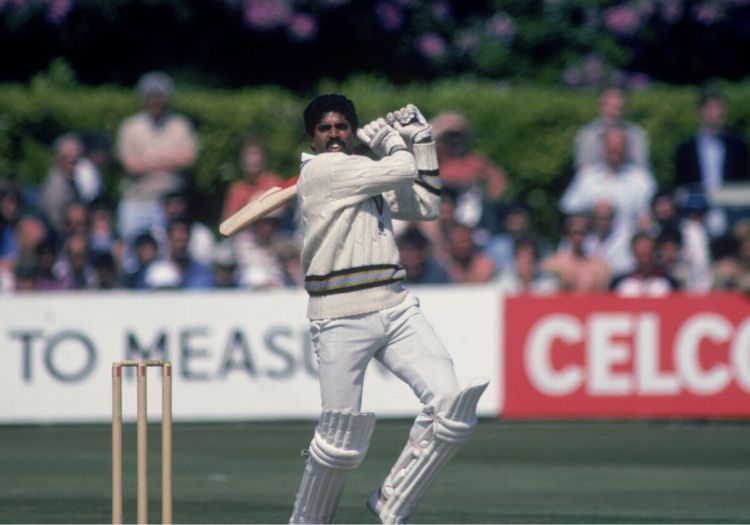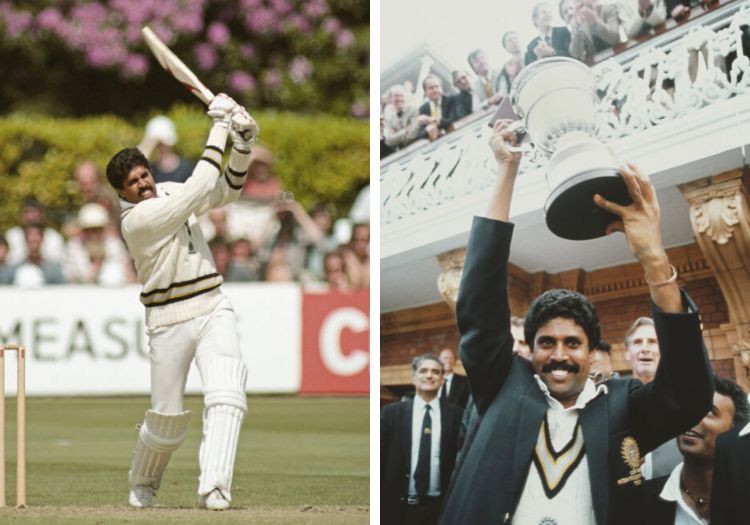India were staring at an early exit from the 1983 World Cup in England when they slipped to 17 for 5 against the outsiders Zimbabwe. But then up stepped Kapil Dev to change the course of cricket's history

Ayaz Memon (Indian journalist): We weren’t a fancied side at all. At the 1979 World Cup in England India had lost to everyone, including Sri Lanka, and most people assumed it would be the same story again.
Kapil Dev (India captain): Three months before the World Cup we beat West Indies in a one-day international in Guyana by scoring 282, the biggest total ever made against them at that time, and defending it with our medium-pacers. We started the World Cup by beating them again in a similar manner and that gave us a lot of confidence.
David Houghton (Zimbabwe keeper-batsman): We were nine years away from Test status but we had a decent team and we made people immediately sit up when we beat Australia in our first match.
With England taking on Pakistan at Old Trafford that same day and a BBC strike causing a TV black-out, few people anticipated many headlines being made at leafy Tunbridge Wells.
Houghton: The Nevill Ground was very similar to the type of club grounds we were used to playing on at home. It was a beautiful day, there was a festive atmosphere and we had a lot of support among the spectators at that match.
Ayaz Memon: It was my first ever trip to England and Tunbridge Wells was the epitome of an English cricket ground, the type you could have read about in an Enid Blyton book. There were at the most 5,000 people there, a lot of them old ladies with hampers and champagne on the boundary’s edge. Soon we figured it was time to have a swig or two because this match wouldn’t be lasting too long.
Jan Traylen (photographer): It was a beautiful ground but the sort of place where you had to be careful about where you placed your stool. You’d get a lot of coughing and spluttering if you obscured the members’ views.
Kapil chose to play to India’s strengths by setting a target for his medium-pacers to defend. But his move backfired spectacularly as Kevin Curran and Peter Rawson sliced through India’s top order.
Houghton: The pitch at Tunbridge Wells encouraged seam movement early on. It had a greenish tinge and the ball nipped around as well as swinging a bit.
'Once he’d found some good solid company he went completely beserk'
Ayaz Memon: I reached the ground a little late after travelling down from London and two wickets had already fallen. I popped into the dressing room before heading for the press tent – in those days there was no problem about access – and while I was chatting with Gundappa Viswanath the fourth and fifth wickets fell.
Traylen: I had found myself a good spot square of the wicket with rhododendrons in the background to get some stock photos of the Indian batsmen playing shots. That didn’t quite work out as I had expected.
Kapil arrived at the crease at 9 for 4, which became 17 for 5 as Yashpal Sharma joined the procession.
Ayaz Memon: Zimbabwe had beaten Australia and had some very good players. Playing at Tunbridge Wells on a seaming track played into their hands as well.
Kapil Dev: I was rushed out of the shower and had very little time to think. I was trying to ask my partner as to what had happened, how we had lost the wickets and obviously I was quite upset at that time.
Houghton: When Kapil came in he just tried to hang on. Roger Binny stayed with him and I remember discussing with Duncan Fletcher, our captain, how long to keep Rawson and Curran going. Duncan was thinking of keeping Rawson going for all his 12 overs and who knows what would have happened if he had?
Ayaz Memon: For Kapil’s first 50 runs I don’t remember him playing many big shots, maybe a couple of boundaries here and there. It was very unlike Kapil Dev. But once he’d found some good solid company and had settled his partnership, he went completely beserk.
John Traicos extracted Binny for a gritty 22 and Ravi Shastri fell to Fletcher one run later. From 78 for 7 Kapil and Madan Lal limped to lunch with their World Cup campaign in tatters.
Sunil Gavaskar (India opening batsman): When we had lost half of our side with less than 20 runs on the board it was not looking good. But Kapil played the best innings I have ever seen in a limited-overs international. It is also the greatest knock played in a World Cup.
Kapil Dev: Of course my main priority was to play out the maximum number of overs in order to save the team from any embarrassment and to put up some sort of total on the scoreboard. But once we stayed in long enough, myself and my lower-order batsmen, we were able to amass a good total to defend.
Houghton: Once Kapil decided to go on to the attack, everything came out of the dead centre of his bat and he didn’t give a chance. They scored at around eight runs an over for their last 20 overs, and that was with both Madan Lal and, when he was out, Syed Kirmani, just concentrating on staying there in support.
Syed Kirmani (India wicketkeeper): When I walked in to bat, at 140 for 8, I told Kaps: “You just play your natural game.” He replied to say we must try to bat for the whole 60 overs and I replied that I would try my best to hold my end up. Kapil’s innings was one of the best I have ever seen. He just murdered the Zimbabwean bowlers towards the end. It was Diwali at Tunbridge Wells.

Left: Dev at Tunbridge Wells. Right: With the trophy at Lord's
Ayaz Memon: A lot of India’s players were considered bits-and-pieces cricketers but most of them had been around for four or five years and in many cases longer. Madan Lal was a very good batsman in domestic cricket, and Kirmani also had some good scores to his name. These were the guys who came good in the crucial matches.
Madan Lal made 17 from 39 balls and Kirmani finished unbeaten on 24 from 56. But while they remained impassive in support of Kapil, life on the boundary’s edge was getting increasingly frantic.
Ayaz Memon: Kapil may have been a lower-order allrounder but he was among the cleanest strikers the game has seen. He had strokes all round the ground, he could cut and hook and pull. But when he drove, he would go right through the line and middle the ball every time.
Traylen: In those days I was mostly shooting black-and-white for magazines but at the back of my mind I was always mindful of the need to get some colour shots for posterity. The film I was using was super-high quality but very slow which made sports action photos particularly challenging. But when Kapil started cutting loose I knew I had to go for it.
Ayaz Memon: These days you see 50 or 60 journalists from India at World Cups. For that tournament there were six of us, and one of us couldn’t make it to Tunbridge Wells that day. It’s fair to say he missed out.
Traylen: There was one other photographer there, Trevor Jones, and maybe an agency guy, but with no BBC and the innings taking off, we were thinking, ‘oh my goodness, we might be on to a big one here’.
Kapil reached his hundred in the 49th over and finished on a world record 175 not out from 138 balls with six sixes and 16 fours. He had single-handedly hoisted India to a formidable total of 266 for 8.
Kapil Dev: In any lengthy career there are always days when you feel it is your day. There is always pride, too, when you are captain of a national side but the thinking part of captaincy is less at that stage of life than later in your career – you tend to operate more on instinct when you are younger.
Ayaz Memon: It was unreal to see him scoring that many. These days totals of 300, even 400, are achievable but in those days more than 250,
even in 60 overs, was considered a victory. To score 175 all by oneself was extraordinary.
'That win against Zimbabwe was a crucial factor in India’s rise in the world game'
Houghton: The funny thing, at half-way, was that we still felt we would win the game anyway. That score was not a huge one, given the pitch was now a belting one for batting and the boundary on one side of the square was very short. We were confident there’d be plenty of gaps for scoring.
India’s medium-pacers had other ideas and, at 113 for 6, Zimbabwe looked out of contention. However, Curran, at No.7, carried the fight with a 93-ball 73. He was ninth out with 37 still needed and only then did India feel safe.
Houghton: What a mammoth all-round cricketer Kevin Curran was. He had better-than-average ability, no more than that, but his unbelievable self-confidence set him apart. No challenge was too great for him and it was such a great loss to Zimbabwean cricket that he died so young last year.
India’s 31-run victory put their campaign firmly back on course. Two days later they sealed their semi-final berth at the expense of Australia and within the week Kapil was lifting the World Cup at Lord’s.
Kapil Dev: That win against Zimbabwe was a crucial factor in India’s rise in the world game. Not only did the Indian team start to think that it could win the big prizes but it gave the country in general a fair bit of confidence as a large number of our youth started to follow the game of cricket. It provided a strong foundation for the further growth of the game in India.
Ayaz Memon: India’s victory in 1983 turned the cricket world upside down. We were thought to be the underdogs of international cricket but beating Australia, England and West Indies completely transformed the way India’s fans related to cricket. Guys like Gavaskar and Kapil, like Bedi and Pataudi before them, had been heroes but we finally found a team to look up to.
Houghton: Everyone rightly looks at that game as a turning point for India’s cricket but who knows what might have happened if we had beaten them? Personally I’m not sure we would have got Test status earlier [than 1992] but we went home feeling a bit empty.
Thirty years on, the Nevill Ground remains a shrine for Indian cricket, even if its day of international status is a thing of the distant past.
Ayaz Memon: I went back in 2004 with Kapil and Kris Srikkanth during the Champions Trophy. We drove down from London but there was just wild grass all over the place. It didn’t look anything like the same ground as in 1983.
Interviews by Mark Baldwin, Andrew Miller
This article was published in the July 2013 edition of The Cricketer - the home of the best cricket analysis and commentary, covering the international, county, women's and amateur game
Save 30% when you subscribe to The Cricketer’s print & digital bundle. £35 for 12 issues